Why Marc Ascoli’s body of work is more relevant than ever before.
Why Marc Ascoli’s body of work is more relevant than ever before.
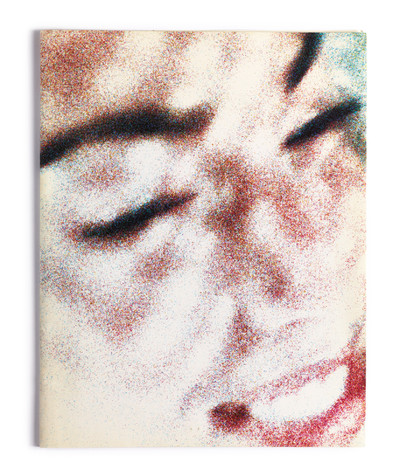
Jil Sander catalogue cover, Spring/Summer 1992. Photographer: Nick Knight.
One of my first ever memories involved the sensuality associated with fashion. As a four-year-old boy growing up in Tunisia, my mum would often drop me off at my grandmother’s apartment while she went out shopping. My grandmother was a demon card player, and each week she’d organise bridge evenings for her friends. All these amazing-looking, blonde women would arrive and throw their fur coats onto my grand- mother’s bed. One evening, when no one was looking, I dived onto the bed and started rolling around in the mass of fur. I can still remember the thrill it gave me, feeling it against my face and inhaling the fragrance of these women.
Fast forward to Paris in the late-1970s: I had a degree in law but was hanging out with people who worked in fashion, and this led me to Martine Sitbon. We met, started working together and moved in together within a very short space of time, and we’ve shared our lives ever since. Martine introduced me to a world of imagery: photography, film noir, la nouvelle vague, art exhibitions, contemporary dance… One day she bought me a book of Avedon photos, and that was it.
Eureka. I suddenly realised that the energy and sensuality of women and clothes that I’d always been drawn to could be expressed through fashion photography. Becoming an art director wasn’t a conscious career choice. It just presented itself to me, even though the role of the Fashion Art Director (yes, they are very much capital letters) hadn’t yet been defined. I probably could have ended up designing clothes or becoming a stylist, but as I’m very chatty I found I had an inherent skill in articulating my ideas to others. I also found that I had a good radar for discovering people who had something new and unique to offer: stylists, photographers, models, graphic designers, assistants. Although I’m quite a fragile person, I have the balls to know if I’ve got someone special in front of me. And when I do, I don’t let go.
For much of the 1980s and 1990s, I was particularly drawn to English photographers: initially Nick Knight, then later David Sims and Craig McDean. I liked their taste and their attitude: that mix of chic and rebellion. They were quite aggressive and provocative, in the way the English often are, and they wouldn’t bow down to anyone. People often talk about English street style, implying that it is something rough or ‘edgy’, but I always found the way Nick, David and Craig portrayed their culture was extremely sophisticated. That’s why I turned to them when I started working with clients like Yohji Yamamoto and Jil Sander, as well as Martine. It’s in my nature to take care of people, and I really cared about these photographers; I tried to provide them with the best conditions in which to create work that meant something.
Working with Yohji, Jil, and Martine brought out an experimental nature in me, and that in turn influenced the people I’d discovered: not just the photographers, but models like Stella Tennant, Kirsten Owen and Guinevere, make-up artists like Pat McGrath and graphic designers like M/M (Paris). We were extremely persistent in the search for creating new forms of beauty and imagery. When I use the word experimental, I don’t mean ‘experimental’ in a groovy-Andy-Warhol-Factory kind of way. It’s more a case of – I’ve got to deliver a catalogue or a campaign to my client, so let’s use this as a pretext to create something new. Something that’s never existed before and perhaps won’t work in the future but right now it’s the essence of the moment. Sometimes it didn’t work; sometimes it created images I’m really proud of. Sometimes, the attitude alone expressed how the client saw the world. We weren’t even showing the clothes.
I’ve always thought that if you don’t experiment, the work won’t be relevant or memorable. When I look at contemporary fashion imagery, I get the feeling quite a lot of it is constructed by fusing a bunch of references together. I believe a successful catalogue or campaign provides the future for the designer: it opens up their esprit, offers inspiration for the next collection and acts as a guide. Over the years, a lot of people have told me that my images triggered their love of fashion, or helped them understand Yohji’s revolutionary vision or Jil’s extreme rigour and sophistication or whatever. It’s not false modesty when I say my principal motor has simply been to create something authentic, something beyond just selling stuff for a client.
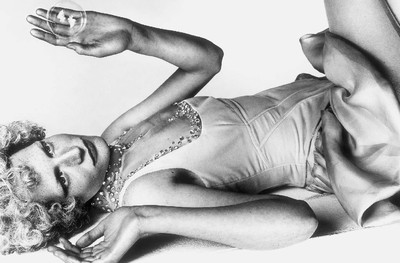
Martine Sitbon catalogue, Autumn/Winter 1991-1992
Photographer: Nick Knight. Model: Kirsten Owen
I first became aware of Nick Knight through a series of portraits he’d done for i-D: Stephen Jones, Daniel Day-Lewis, Morrissey, Paul Weller, Michael Clark, Katharine Hamnett… He was clearly influenced by David Bailey, but he’d updated that to create something fresh and modern. He’d got his portrait subjects to use their arms and hands to adopt poses; it could so easily have been horribly clichéd or naff but there was an elegance and simplicity that I was drawn to. It’s also what makes this image of Kirsten so arresting. Nick and I first met in London, and when he started talking I sensed he had extraordinary talent. He spoke French, but with a slight Belgian accent because his father had been a diplomat, and he’d grown up in Belgium. Nonetheless, he remains the quintessential English photographer: reserved, delicate, attentive, intense, rigorous, refined, calm and persistent. A dandy in a white Oxford shirt and flannels, drinking tea. His photography is an authentic reflection of who and what he is, and that still comes across today on SHOWstudio.
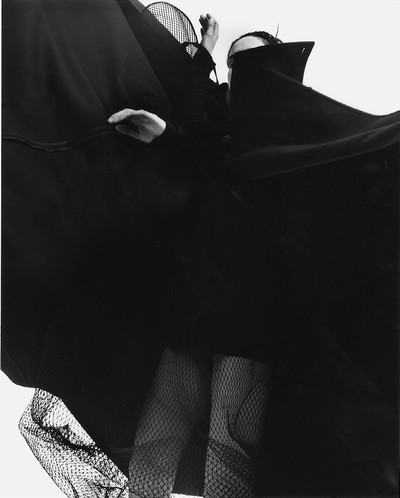
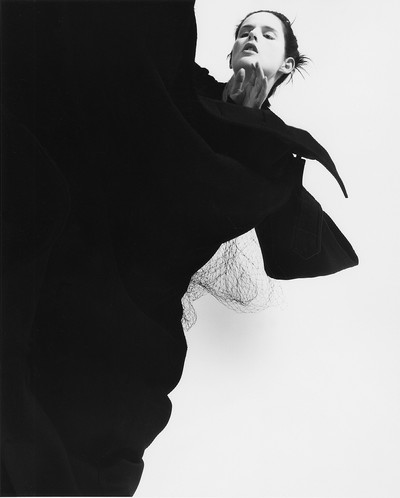
Yohji Yamamoto catalogue, Autumn/Winter 1995-1996
Photographer: David Sims. Model: Stella Tennant
Yohji Yamamoto’s brief was: there is no brief. I worked for Yohji for 12 years – on and off – and each season I just flew out to Tokyo and presented him with the final maquette. I never had to ‘sell’ a photographer or model to him. This might sound like the perfect scenario but it was extremely demanding: you have to have big balls and strong convictions to pluck something out of nowhere. I’d stopped for a few seasons and then Yohji asked me to come back for this catalogue. I was looking for something fresh and provocative and I sensed David Sims had something to say and wanted to shake things up. When I met him he’d just had his confidence knocked doing a big Calvin Klein campaign that didn’t work out. He was disillusioned and a bit angry, which was perfect for what I was hoping to achieve for my Yohji ‘comeback’. I didn’t need to show David any references; Yohji was the reference. This was fashion charged with meaning, it represented the death of the logo. You didn’t buy Yohji or Comme, you collected them.
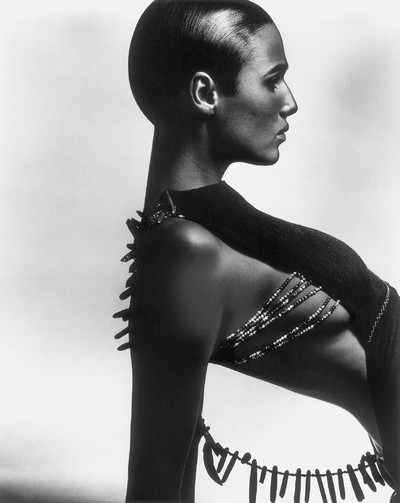
Martine Sitbon catalogue, 1990
Photographer: Nick Knight. Model: Amanda Cazalet
When we started out, Nick didn’t know that much about fashion photography, but he totally trusted me and absorbed what I showed him. As well as the obvious starting points – Avedon, Penn, Bailey – we discussed the work of Blumenfeld and Outerbridge and particularly Man Ray, which you can definitely sense in this image. Nick would shoot with a large-format 8x10 camera which was time- consuming, but that gave us the time to think and experiment. Plus, each frame shot would cost a fortune in film and Polaroid, so there was a sense that what you were doing was precious, which isn’t the case now when you’re shooting digital. Nick, by his very nature, is experimental, and back then the darkroom was where his printing experiments broke new ground. This picture was originally shot in colour, but in printing the model appears almost black and with an incredible sensuality. There’s actually a lot of dignity in her pose: you can sense the formality of England, and the classical references are in there.
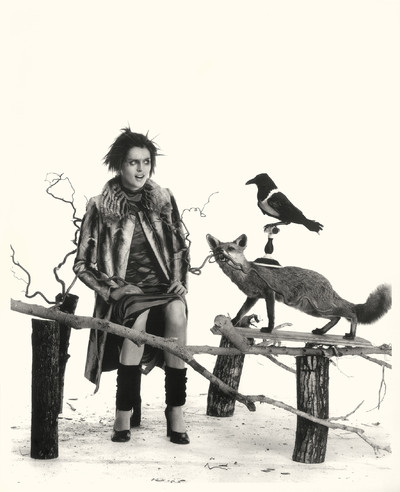
Martine Sitbon catalogue, Autumn/Winter 1997-1998
Photographer: Craig McDean. Model: Stella Tennant
Craig McDean had been Nick’s assistant, so he too had absorbed the references I’d been showing. Where I guided Craig was towards an understanding of femininity, in the ways someone like Irving Penn did. Craig has an extraordinary gift for tapping into female beauty and attitude, and the way he captures Stella makes this such a modern-looking picture. Both Martine and Stella love taxidermy; I think Stella even studied it at one point. The stuffed animals were inspired by a Penn photo with taxidermy, as well as a Bailey picture in which the model is wearing a fluffy sweater and crouching down to look at a squirrel. We had a lorry-full of stuffed animals from Deyrolle, and we’d all take turns going out to fetch a fox or a crow or something. I have to say this was a great collection from Martine, and it had a lot of success. It’s not by chance that most great fashion images feature beautiful collections. You can have all the budget in the world and get whoever you want to work with, but if the clothes aren’t saying much you’re not going to create magic.
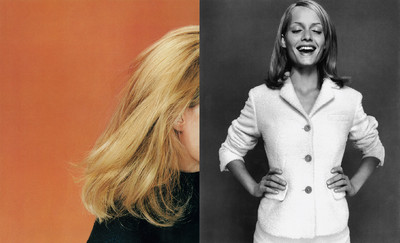
Jil Sander catalogue, Autumn/Winter 1995-1996
Photographer: Craig McDean. Model: Amber Valletta
This was the era of the supermodel – Christy, Linda, Tatjana, Naomi – photographed by Lindbergh and Meisel. Then Amber Valletta came along as a bit of a tomboy. This was shot at the beginning of her career; she was a real beauty, but she didn’t give a shit and just burst out laughing on the shoot. When you consider the formality and rigour that typifies Jil Sander – both the woman and the brand – the spontaneity of Amber’s outburst is all the more incongruous. It’s what makes the picture so memorable, along with the great M/M (Paris) layout. I had less freedom working with Jil Sander because these were images clearly designed to make people spend money in exchange for status and power. This was fashion for the uptown – not grunge – but with a twist of anti-conventionalism that comes from her sheer obsession with quality. Jil loved the campaign and, as she was advertising a lot in those days, I kept seeing the right-hand image plastered full page in the International Herald Tribune. The perfect setting for it, I’d say.
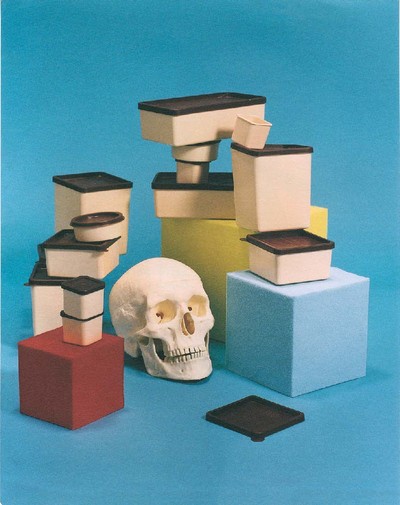
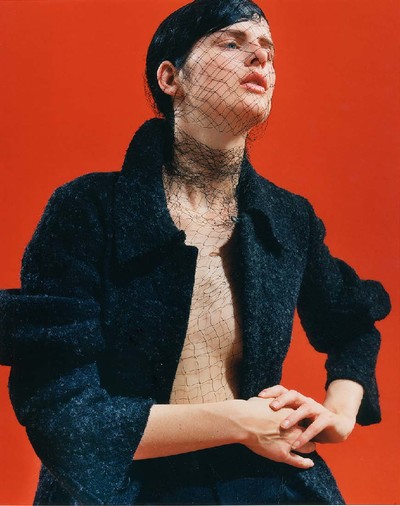
Yohji Yamamoto catalogue, Autumn/Winter 1995-1996
Photographer: David Sims. Model: Stella Tennant
Shooting fashion catalogues in the 1990s was born out of the Japanese culture of exquisite book publishing. Comme started doing small-print runs of catalogues in the late 1970s, and so it was natural for Yohji to do the same. Far from the power status of Jil Sander’s imagery, these were not destined for glossy magazines; we weren’t selling per se. David Sims is such a charismatic photographer, a real seducer, but not in a naff way. I remember it being really hot in the studio when we shot this, and David opened up Stella’s jacket to reveal this hint of sexuality, even though her body was covered by the delicate black veil. The hot red background suggests an extra frisson of excitement, where- as the opposite page is constructed around this hideous shade of turquoise which was purposely out of step with the clean and considered tones of the 1990s. The still life with the Tupperware and human skull added further incongruity to the dialogue between the two images. Incongruous yet strangely harmonious.
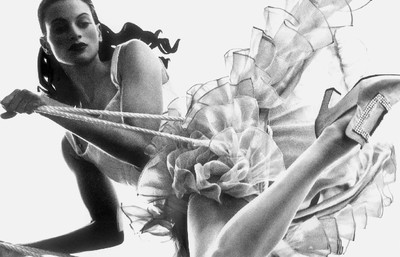
Martine Sitbon catalogue, Autumn/Winter 1991-1992
Photographer: Nick Knight. Model: Kristen McMenamy
Creating images with Martine has always been about instinct rather than long discussions. The purpose of these pictures wasn’t to elevate the clothes to objets sacrés, it was simply about creating a continuation of the emotions that we had found in the collections. Martine’s photographic culture is extraordinary; she combines a sophisticated knowledge of photography history with the fact that she knew people like Guy Bourdin. She modelled for him, too. I had a sensibility for imagery, but she was the person who discovered it. I consider these pictures as the middle ground between dreamlike sequences and something a little unsettling, and Kristen McMenamy is the perfect girl to portray this. Nick was shooting with a large-format camera, and so Kristen had to maintain this extraordinary pose and expression time, and time again while Nick would be saying, ‘Don’t move it.’ It’s thanks to their collective commitment that we got this image that sits somewhere between fantasy and reality – un moment suspendu.
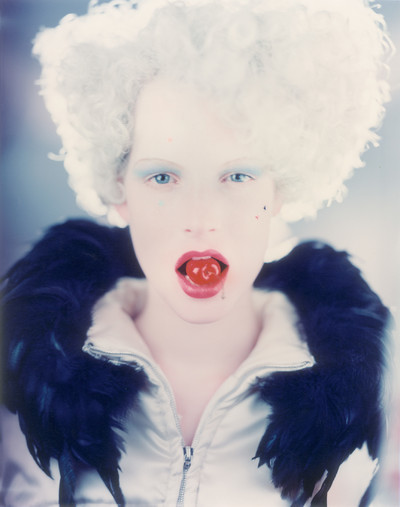
Martine Sitbon catalogue, Autumn/Winter 1991-1992
Photographer: Nick Knight. Model: Kirsten Owen
While Yohji adopts an almost asexual approach to women, Martine is far more sensual, as this picture shows. I cast Kirsten Owen completely by chance: I remember seeing her walk by at Pin-Up studios one day, and I just grabbed her and asked if she was free to shoot with us the following day, it was one of the first jobs she’d done. The resulting image is a mix of a number of different things: it’s quite rock ’n’ roll, but a bit like a weird 1970s David Bowie era androgynous albino, if such a thing could exist! There’s also the sexuality of Donna Jordan posing for Antonio Lopez, although the hair actually comes from the Jane Campion film called An Angel at My Table. Looking at it today, I can see the combination of Martine’s poetic side with the boldness of Nick. Martine’s always been a gourmand, and I think we just spontaneously bought the cherries and started experimenting with them. When A Magazine did an issue curated by Martine, I cropped in on the mouth with the cherry to use as the cover image, heightening the sensuality.
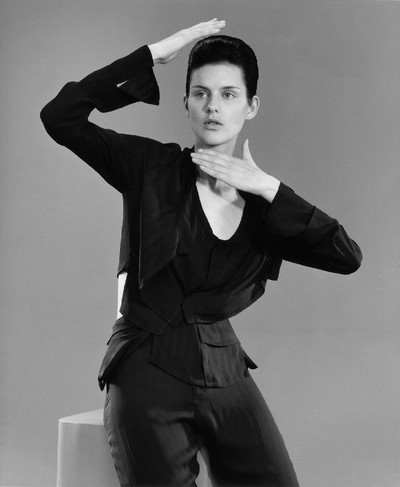
Yohji Yamamoto catalogue, Spring/Summer 1996
Photographer: David Sims. Model: Stella Tennant
As well as having a wonderful character, Stella is extraordinarily proportioned. But why is her success as a model so long lasting? I think there is an omnipotence to her: she puts on the clothes, and she immediately becomes the perfect model; she has a natural sensibility, and she loves playing the role. I often go to contemporary dance performances, and I was a big admirer of Pina Bausch. The freeform energy of dance is something I’ve always tried to bring into fashion imagery it seems like a natural thing to do. The pose here is very Bowie on the Heroes cover, which in turn was inspired by Japanese performance but I think it’s the amazing Roy Orbison grooming that makes this image what it is. I really wanted to take Yohji elsewhere that season – to give him a kick – but I don’t think he was very open to these new socio-cultural changes that I was experiencing. When I went to Tokyo to show him the work, he looked at me and said, ‘Culture shock’. We then went off to have a great dinner together but never discussed the images again. [Laughs].
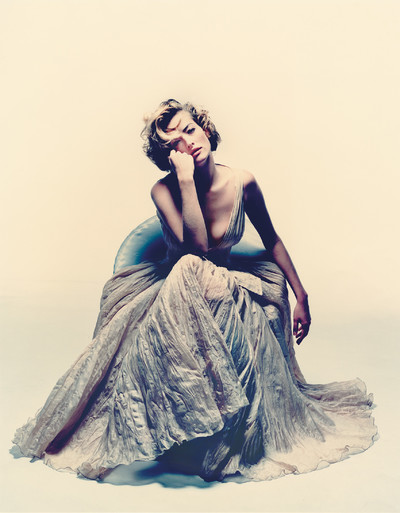
Jil Sander catalogue, Spring/Summer 1992
Photographer: Nick Knight. Model: Tatjana Patitz
Over the years I was working for Jil Sander, I was always conflicted about whether we were selling clothes or wanting to give life and meaning to the collection. For me, this image was all about one thing: highlighting the sensuality at Jil Sander, despite its reputation for rigour. I had already imagined Tatjana wearing this dress as one of the key images of the season, and to create it I needed Nick to replace his conceptual approach with a sensual one. I brought in a hair stylist who I never normally worked with called Valentin, a guy who had worked with Newton and Bourdin. He made Tatjana look dreamlike, like Marilyn Monroe. The other exceptional thing about the image is the colour quality of the print that Nick achieved. The background in the studio was white, but once he’d experimented in the darkroom, he transformed it into an elegant and sophisticated tone, a bit like crushed seashells. I remember Jil turning up to the shoot; although she didn’t have the patience to stick around all day, she loved this image.
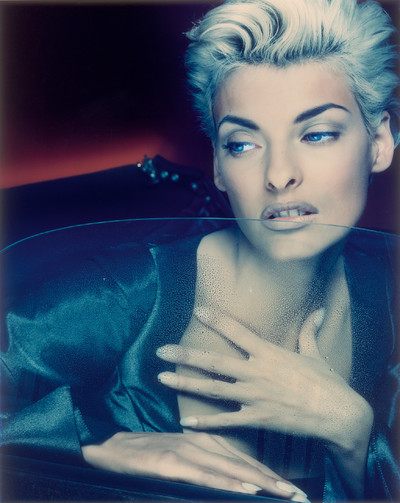
Jil Sander campaign, Autumn/Winter 1991-1992
Photographer: Nick Knight. Model: Linda Evangelista
Why Linda for Jil? Nick and I wanted to take her extreme fame and play with it, interpret her differently by using the clothes of Jil Sander. Nevertheless, when she came to the studio, it was all about her. Which was to be expected. She was far more famous than Nick, she was a superstar! You have to remember this pre-dated the ‘starification’ of fashion insiders, there were no blogs called I Want To Be A Roitfeld. She’d worked all the time with Meisel, and then Nick Knight shot her blonde. I have to say that she was great; she arrived, and it was full on, but she played along with our concept, and there weren’t any hissy fits. I think she wanted to prove to us that she was at the top of her game. And that’s exactly what she did. We fell completely under her charm, and I remember being kind of starstruck to a certain extent, which is something you no longer really get with models because they all seem interchangeable. Frankly, Linda was born to be a model! This picture is a lesson in grace: the look, the pose, Linda Cantello’s fabulous make-up.
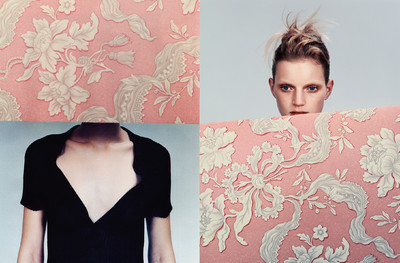
Jil Sander catalogue, Spring/Summer 1996
Photographer: Craig McDean. Model: Guinevere van Seenus
The 1990s woman was of course ‘grunge’, and even though I’m not a slave to scenes, I was drawn to its radical sense of change. Once again, music had a huge impact on fashion, with brands like Prada moving away from minimal sophistication towards something more lo-fi. And while Jil Sander – with her luxurious silks and cashmeres – had never been particularly grunge in spirit, I felt it would bring the brand a new sense of distinction. This is one of Guinevere’s first ever jobs, and she looks proud and sexy which creates a nice tension along with the banal wallpaper. This particular pattern has existed since about 1957, and you can probably still get it today; it’s not even considered vintage, it’s just the sort you probably find in reasonably priced hotels. Wrapping it around the sophistication of Jil Sander would create confrontation, and I was right: the then President of the company despised these images with a passion! But he still took advertising in American Vogue to make sure people knew Jil Sander was creating them.